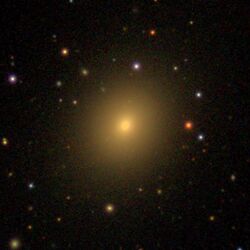Astronomy:NGC 777
From HandWiki
Short description: Galaxy in the constellation Triangulum
| NGC 777 | |
|---|---|
 NGC 777 | |
| Observation data (J2000 epoch) | |
| Constellation | Triangulum |
| Right ascension | 2h 00m 14.907s[1] |
| Declination | 31° 25′ 46″[1] |
| Redshift | 0.016708[1] |
| Helio radial velocity | 5,015 km/s[2] |
| Distance | 189 million ly (58.075 mpc)[2] |
| Apparent magnitude (V) | 12[3] |
| Characteristics | |
| Type | E1[3] |
| Apparent size (V) | 2.5' x 2.0'[3] |
| Other designations | |
| CGCG 503-67, MCG 5-5-38, PGC 7584, UGC 1476 | |
NGC 777 is an elliptical galaxy in the constellation of Triangulum. It was discovered by William Herschel on September 12, 1784. It has a weak active nucleus of type Seyfert 2 or LINER 2,[4] implying that the central region is obscured. It may be an outlying member of galaxy cluster Abell 262.[5]
References
- ↑ 1.0 1.1 1.2 "NGC 777". SIMBAD. Centre de données astronomiques de Strasbourg. http://simbad.u-strasbg.fr/simbad/sim-basic?Ident=NGC+777.
- ↑ 2.0 2.1 "Results for Object NGC 0777". NASA/IPAC Extragalactic Database. https://ned.ipac.caltech.edu/ui/?q=objsearch&omegam=0.27&extend=no&out_csys=Equatorial&objname=NGC%20777&hconst=73&img_stamp=YES&list_limit=5&of=pre_text&out_equinox=J2000.0&corr_z=1&omegav=0.73&obj_sort=RA%20or%20Longitude.
- ↑ 3.0 3.1 3.2 "New General Catalog Objects: NGC 750 - 799". Cseligman. http://cseligman.com/text/atlas/ngc7a.htm#777.
- ↑ Ho, Luis C.; Filippenko, Alexei V.; Sargent, Wallace L. W. (1997). "A Search for "Dwarf" Seyfert Nuclei. III. Spectroscopic Parameters and Properties of the Host Galaxies". The Astrophysical Journal Supplement Series 112 (2): 315–390. doi:10.1086/313041. Bibcode: 1997ApJS..112..315H.
- ↑ Faber, S. M. (1989). "Spectroscopy and Photometry of Elliptical Galaxies. VI. Sample Selection and Data Summary". The Astrophysical Journal Supplement Series 69: 763–808. doi:10.1086/191327. Bibcode: 1989ApJS...69..763F.
External links
 |

